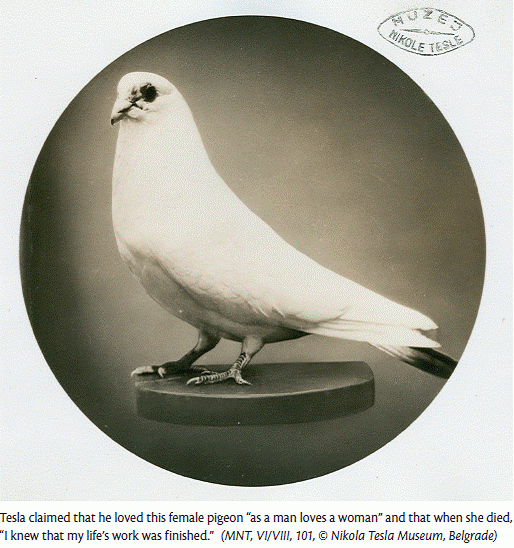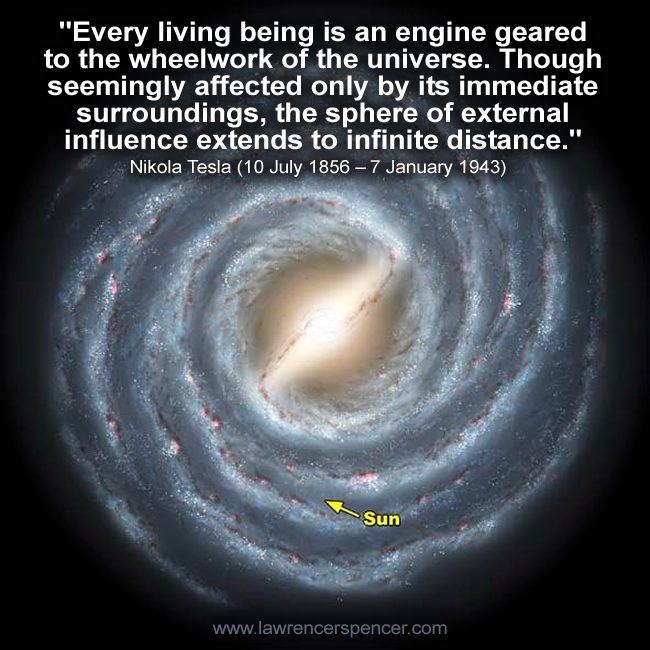Republished by Blog Post Promoter
I personally recommend that every serious student of Life, Universes and Other Stuff, read the autobiography of Nikola Tesla, titled, “MY INVENTIONS“. Serbian inventor NIKOLA TESLA (1857-1943) was a revolutionary scientist who forever changed the scientific fields of electricity and magnetism. Tesla’s greatest invention, A/C current, powers almost all of the technological wonders in the world today, from home heating to computers to high-tech robotics. His discoveries gave mankind the television. And his dream of wireless communication came to pass in both the radio and eventually the cell phone. Yet his story remains widely unknown.
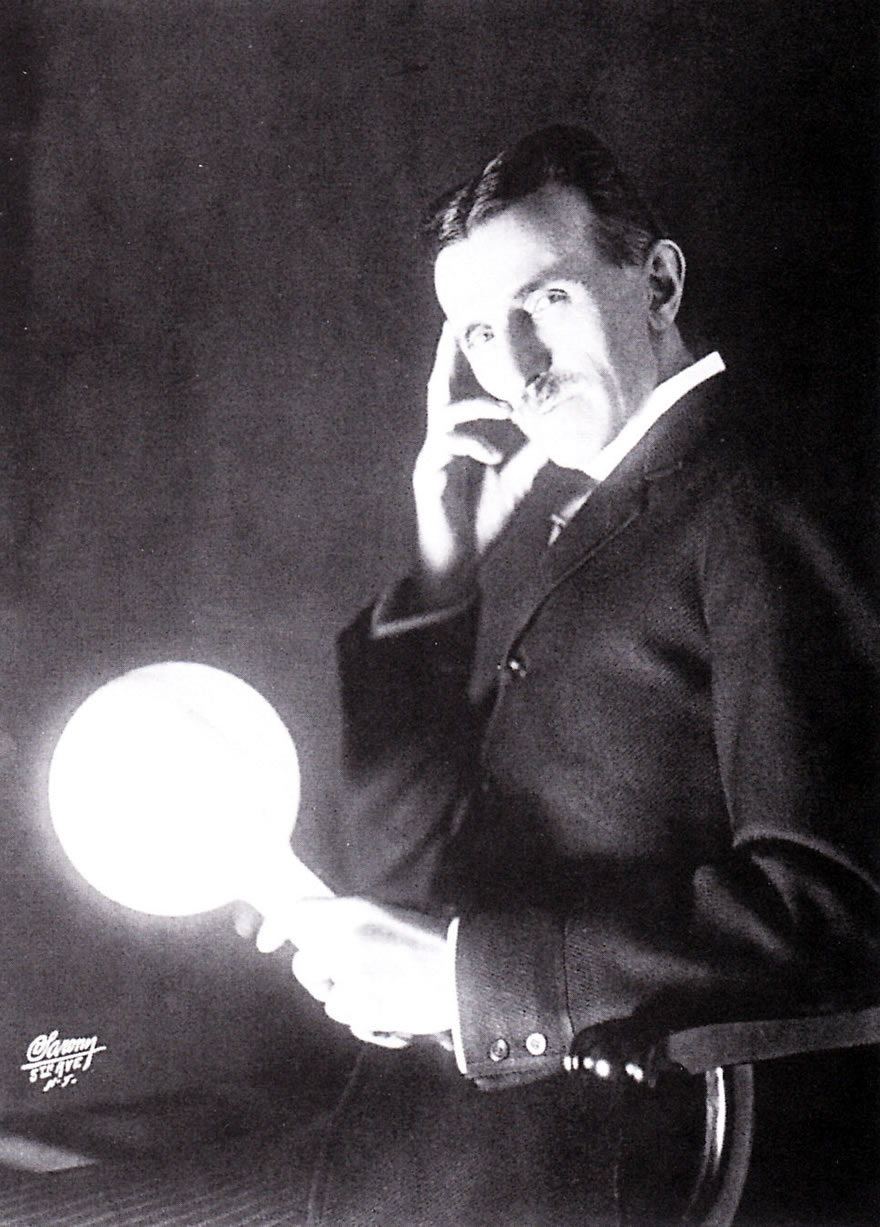
Tesla with one of his famous “wireless” lamps. Published on the cover of the Electrical Experimenter in 1919.
Few inventors contributed more to advances in science and engineering in the early 20th century than Nikola Tesla. As one of the Fathers of Electricity, Tesla did groundbreaking work on alternating current (AC) power system, electromagnetism, hydroelectric power, radio, and radar to name a few. Many of his inventions (Tesla obtained some 300 patents in his lifetime) became the stuff we take for granted today: when we flip a switch to turn on the light, we owe a lot of that electrical magic to Tesla.
As fate would have it, Tesla, one of the world’s greatest inventors, died penniless and in obscurity. Even today, many people mistakenly attribute many of his inventions to others (Edison, for example, is in the name of many power companies in the United States – ironically, they use the AC system devised by Tesla rather than the more inefficient direct current or DC system espoused by Thomas Edison; Tesla also invented the fundamentals of radio transmissions before Gugliegmo Marconi).
Today, there’s quite a bit of resurgence in Tesla’s popularity, which is helped in part by his mystique as a “mad scientist.” Amongst his more outlandish ideas, Tesla worked on death rays to knock out enemy airplanes out of the skies, pocket-sized resonance machine that could topple buildings, ways to send electricity through the upper atmosphere, force-fields to protect cities, and so on.
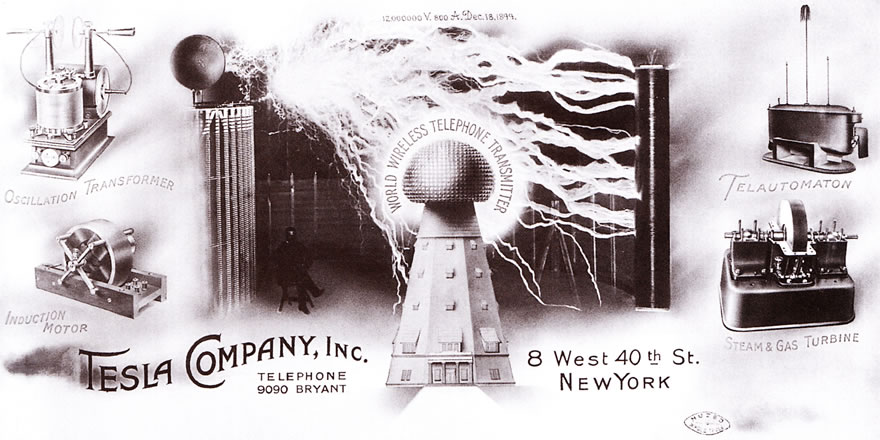
Tesla Company letterhead. Note the words “World Wireless Telephone Transmitter.”
In their book, Tesla: Master of Lightning , authors Margaret Cheney and Robert Uth tell the story of the enigmatic genius from his birth in a little village in what is Croatia today, to his lonely death in a New York hotel room. The book, years in the making, combines archival documents and hundreds of photographs, compiled from the Tesla Museum in Belgrade (previously inaccessible to Western writers during much of the Cold War era), excerpts from Tesla’s writings, as well as interviews with people who knew the man personally, to paint detailed snapshots of Tesla’s life and to provide clear explanations of his (often very technical) work.
, authors Margaret Cheney and Robert Uth tell the story of the enigmatic genius from his birth in a little village in what is Croatia today, to his lonely death in a New York hotel room. The book, years in the making, combines archival documents and hundreds of photographs, compiled from the Tesla Museum in Belgrade (previously inaccessible to Western writers during much of the Cold War era), excerpts from Tesla’s writings, as well as interviews with people who knew the man personally, to paint detailed snapshots of Tesla’s life and to provide clear explanations of his (often very technical) work.
On a personal note, it has taken me far longer than I expected to write this excerpt for Neatorama Spotlight. Margaret and Robert’s book was so fascinating that on many nights, I ended up reading late pass my bedtime. It seems like on every single page there were neat details about Tesla that were just too good not to share! I highly recommend Tesla: Master of Lightning to anyone interested in learning more about the legendary Nikola Tesla.
to anyone interested in learning more about the legendary Nikola Tesla.
Excerpts from Tesla: Master of Lightning, by Margaret Cheney and Robert Uth:
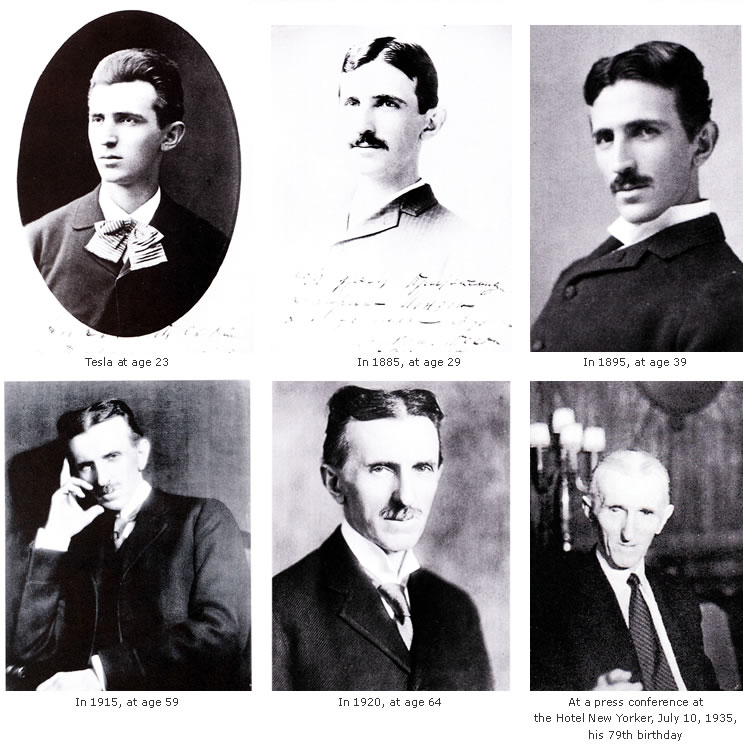
An Old World Childhood
As a youth, Tesla exhibited a peculiar trait that he considered the basis
of all his invention. He had an abnormal ability, usually involuntary,
to visualize scenes, people, and things so vividly that he was sometimes
unsure of what was real and what imaginary. Strong flashes of light often
accompanied these images. Tormented, he would move his hand in front of his eyes to determine whether the objects were simply in his mind or outside. He considered the strange ability an affliction at first, but for an inventor it could be a gift.
Tesla wrote of these phenomena and of his efforts to find an explanation
for them, since no psychologist or physiologist was ever able to help
him. "The theory I have formulated," he wrote much later, is
that the images were the result of a reflex action from the brain on the
retina under great excitation. They certainly were not hallucinations,
for in other respects I was normal and composed. To give an idea of my
distress, suppose that I had witnessed a funeral or some such nerve-wracking spectacle. Then, inevitably, in the stillness of the night, a vivid picture of the scene would thrust itself before my eyes and persist despite all my efforts to banish it. Sometimes it would even remain fixed in space though I pushed my hand through it. (Tesla, My inventions: My early life. -- Electrical Experimenter; February 1919)
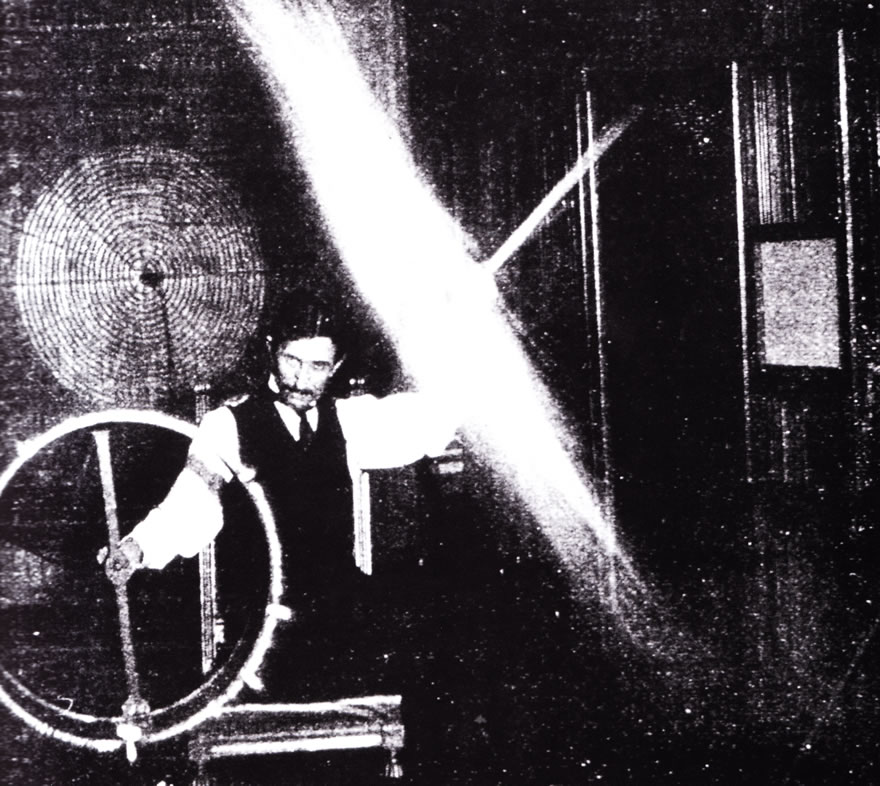
Tesla in his Houston Street laboratory. Caption for this photo in Electrical
Review, March 29, 1899 reads: "The operator's body, in this
experiment, is charged to a high potential by means of a coil responsive
to the waves transmitted to it from a distant oscillator."
Geniuses Collide
On the summer day in 1884 when Tesla, carefully dressed in his bowler
hat, striped trousers, and cut-away coat (the whole of his wardrobe),
dropped in to see the famous Mr. Edison, there had been an emergency at the Vanderbilt mansion on Fifth Avenue. Two wires had shorted behind a metallic-threaded wall hanging and started a fire. Mrs. Vanderbilt herself had smothered the flames, only to learn that the problem emanated from a steam engine and boiler in her basement. Now the angry socialite was demanding that Edison remove the whole apparatus. No sooner had he rushed back to Pearl Street than the manager of a shipping firm called to remind him that the SS Oregon had been tied up for days awaiting electrical repairs and was losing money by the hour. Unfortunately Edison had no more engineers to assign to the job.
At this juncture he became aware of the tall foreign gentleman hovering
politely in the doorway, bowler hat in gloved hand, a letter in his pocket
from Charles Batchelor, the English engineer who managed the Continental Edison Company in Europe. Few American colleges then trained electrical engineers, so prospects were good for the rare immigrant who was qualified. But Mr. Edison was not in a congenial mood. Tesla spoke up, knowing the famous man had a had a hearing problem, and introduced himself. He produced the brief message from Batchelor. Edison glanced at the few lines and snorted. "I know two great men and you are one of them," Batchelor had written. "The other is this
young man!"
Thomas Edison, rumpled, weary, and deeply skeptical, asked Tesla what
he could do. While the American inventor was only eight years older than his visitor, and lacked his formal education, he was already world-renowned for his inventions. Tesla recalled their meeting:
When I saw this wonderful man, who had had no training at all, no advantages, and who did it all himself, and saw the great results by virtue of his industry and application - you see, I had studied a dozen languages ... and had spent the best years of my life ruminating through libraries. I thought to myself what a terrible thing it was to have wasted my life on those useless things, and if I had only come to America right then and there and devoted all of my brain power and inventiveness to my work, what could I not have done? (Tesla, My inventions: My early life. -- Electrical Experimenter; February 1919)
In awe of Edison, Tesla proceeded to describe the engineering work he
had done in France and Germany, and spoke of his plans for induction motors made to run smoothly and powerfully on alternating current. That invention, he reckoned, was worth many fortunes.
Edison knew little of alternating current, chose to believe it the work
of the devil, and did not care to learn more about it. Did this dandified
"Parisian" realize that was he was suggesting could make a whole
industry obsolete? In the past Edison had waged a propaganda war against the gas companies on the grounds that the possibility of explosions made gas too dangerous for human use as a power source. He was therefore experienced in recognizing and heading off any threat of industrial competition.
Tesla, unprepared for the force of Edison's passion, thanked him and
turned to leave. As he did so a breathless boy rushed into the plant to
report that a junction box at Pearl and Nassau streets was leaking electricity and had injured a carter and his horse. Edison bellowed at his foreman. Then he turned to Tesla and said, "Hold up a minute, Mister. Can you fix a ship's lighting plant?"
So began this historic collision of geniuses. Eventually it would spark
the bitter and long-running "War of the Currents," the taste
of which still lingers today in corporate memories.
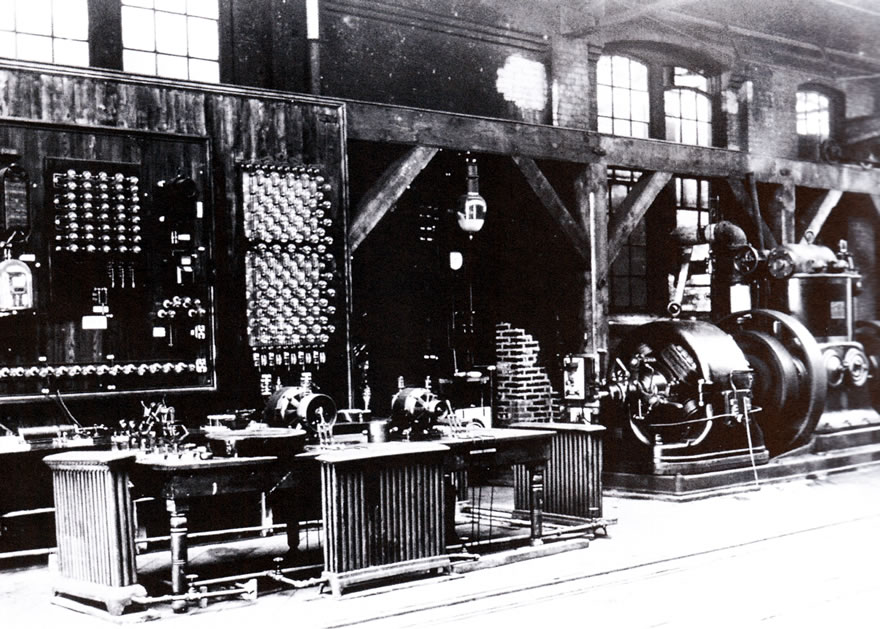
Laboratory where TEsla and Westinghouse engineers developed apparatus for AC systems. Tesla's exhibit with his "Egg of Columbus," which stood on end when the table it rested on was magnetically excited by AC. Another smaller table with ball can be seen to the left; to the right, an early high-frequency machine.
The Executioner’s Current
It is strange but true that the introduction of the electric chair in
America came purely out of a commercial battle over light bulb sales.
Or, more accurately, over what kind of power supply would energize the
nation's early lighting. Orders to Edison's lighting companies had fallen
behind those for Westinghouse's newer AC systems. With progress marching right past him, Edison and his Wall Street investors opened a delaying campaign to block AC systems in any way possible, the DC interests took up the idea that AC would fail if it was perceived as deadly. One shadowy figure associated with Edison, Harold P. Brown, became a very public advocate of "humane" death - to be inflicted on animals or humans - by AC electricity. Brown electrocuted dogs and horses under questionable experimental conditions. After Edison provided him with research facilities at his West Orange, New Jersey, laboratory, neighbors began to complain of disappearing household pets.
Brown's efforts inspired New York State prison officials to try the idea
on a human being. A law was passed in New York (1887) to abandon hanging in favor of electrocution as of January 1, 1889.
Brown, predictably, had a hand in providing apparatus to the state -
a 2,000-volt Westinghouse alternator purchased secondhand - since Westinghouse refused to sell when approached. First to die by the newly prescribed capital punishment was William Kemmler, convicted of killing his wife.
He was executed at the Auburn Prison, August 6, 1890. Several jolts were
delivered, one for seventeen seconds and another for three and a half
minutes. Witnesses reported that the victim's spinal cord burst into flames. The method hasn't worked very predictably, even up to today. A number of terms were suggested for this new method of execution, including "thanelectrize," "electrophon," "electroctasy,"
"electrotony," and "fulmenvoltacuss." And why "electrocute,"
also on the list, should have come to be preferred over the straightforward "electrocize" is anyone's guess. The vested interest in DC current, however, made a point of saying victims of electric shocks had been "Westinghoused."
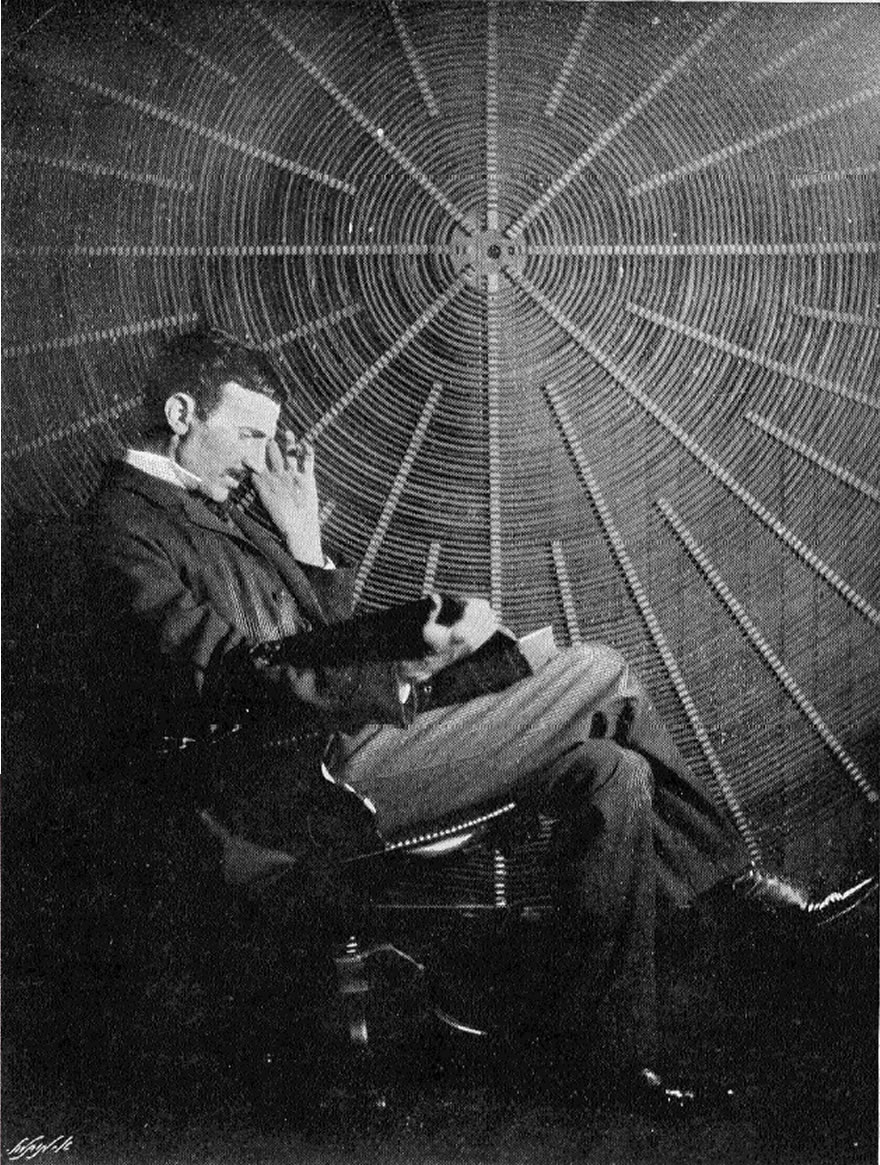
Tesla in a thoughtful pose in front of his “web” coil, May 1896.
Lionized and Ionized
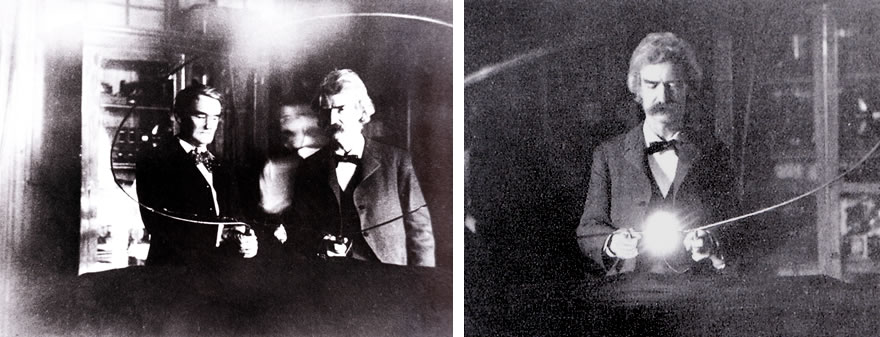
(L) Mark Twain and Joseph ("Jo") Jefferson in Tesla's South
Fifth Avenue laboratory, 1894, with blurred image of TEsla between.(R) Mark Twain in Tesla's laboratory at 35 South Fifth Avenue, early 1895
Perhaps Tesla's most famous friend was the writer Mark Twain, with whom the Serb's literary connections went back to childhood. In his autobiography, Tesla described how Twain helped him recover from a dangerous illness when he was brought the early novels from his local public library and found them "so captivating as to make me utterly forget my hopeless state." He attributed the miraculous recovery that followed to the humorist. Tesla claims that twenty-five years later, when he met Twain in New York, he told him the touching story "and was amazed to see that great man of laughter burst into tears" (Tesla, My inventions: My later endeavors. Electrical Experimenter; 1919)
In Mark Twain's Notebooks & Journals, the author mentions
reading about the sale to Westinghouse of Tesla's electrical patents,
"which will revolutionize the whole electric business of the world."
Twain had made a bad investment - one of many - in the development of
a new DC motor, and was drawn to Tesla for answers. The answer was that this motor had been rendered obsolete by Tesla's polyphase AC. Because this appears to have been the occasion for their first meeting, Twain's tears may have had a more pecuniary cause.
On that basis, the two men became lifelong friends and, incidentally,
fellow members of the posh Players Club. Twain later was instrumental
in encouraging Tesla to pursue his futuristic weapons for shifting war's
destructiveness from men to machines, it then being innocently thought
that wars would cease when weapons became too horrible to contemplate.
Mark Twain was one of the friends most often invited to Tesla's laboratory for the improvisational shows of fright and delight. On one particular evening Twain himself inadvertently furnished the entertainment when he insisted upon experiencing the gyrations of a platform mounted on an electrical oscillator. Tesla pretended to dissuade him, which of course made Twain all the more desirous of prolonging the test. Once on the machine he kept saying, "More, Tesla, more!" But soon he was crying for help, since an undesired effect of the oscillations on the human body was to create a turmoil in the bowels.
When he was next invited to the laboratory, a wiser Twain wrote: "Friday,
Midnight. Dear Mr. Tesla: I am desperately sorry, but a matter of unavoidable business has intruded itself and bars me from coming down ... I am very, very sorry. Do forgive me." (Twain n.d.).
Colorado Springs
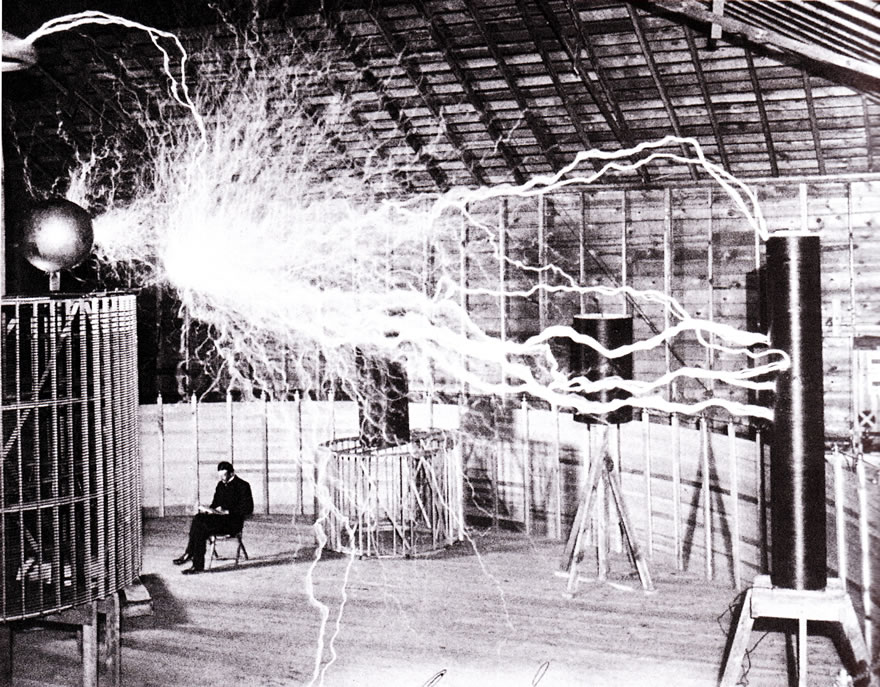
This publicity photo taken at Colorado Springs was a double exposure.
Tesla poses with his "magnifying transmitter" capable of producing millions of volts of electricity. The discharge here is twenty-two feet in length.
In a patent filed the previous year, "System of Transmission of
Electrical Energy" (number 645,576), [Tesla] claimed "it has
become possible to transmit through even moderately rarefied strata of
atmosphere electrical energy to practically any amount and to any distance."
[...] A friend and patent lawyer, Leonard E. Curtis, on being advised
of Tesla's scheme, offered to find land and provide power for his research from the El Paso Power Company of Colorado Springs [...]
The laboratory that began to rise from the prairie floor was both wired
and weird, a contraption with a roof that rolled back to prevent it from
catching fire, and a wooden tower that soared up to eighty feet. Above
it was a 142-foot metal mast supporting a large copper ball. Inside the
strange wooden structure, technicians began to assemble an enormous Tesla coil. The frame on which the heavy primary and 17-turn secondary coils were wound had a diameter of fifty-one feet. The third coil within it
was eight feet in diameter, with a hundred turns of wire. This enormous
air-core transformer could deliver a current of 1,100 amperes. The mysterious "extra coil" in the center magnified the electrical effects
through a process called "resonant rise." The function of this
coil was not understood until the 1970s.
Builders erected a high fence around the site, and signs appeared on
every post - KEEP OUT. GREAT DANGER - in hopes of keeping the curious
at a distance. Fritz Löwenstein could not resist posting at the door
another sign, quoting Dante's Inferno: "Abandon hope, all
ye who enter here." [...]
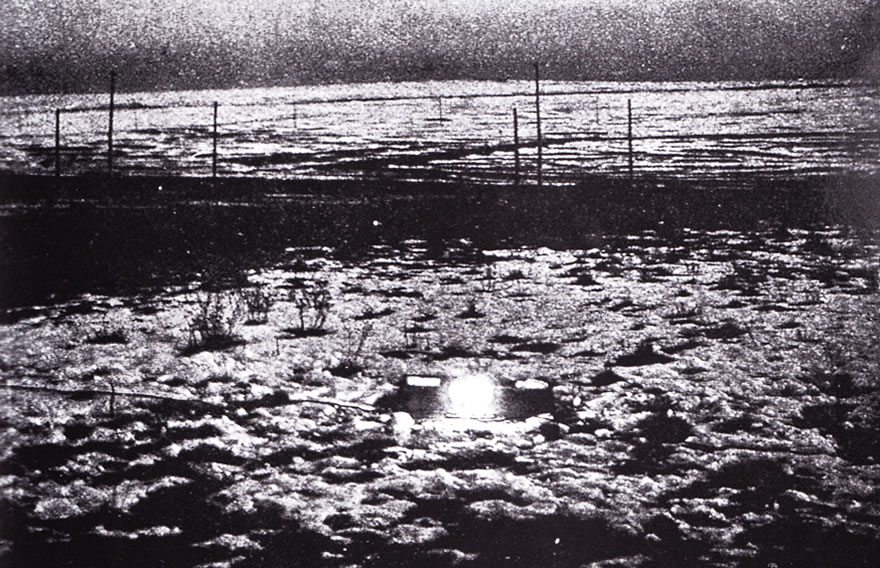
Caption in Century Magazine, June 1900, reads: "The photograph
shows three ordinary incandescent lamps lighted to full candle-power by
currents induced in a local loop consisting of a single wire forming a
square of fifty feet each side, which includes the lamps, and which is
at a distance of one hundred feet from the primary circuit energized by
the oscillator."
To test his theory, Tesla had to become the first man to make electrical
effects on the scale of lightning. The giant transmitter was arranged
accordingly. On the evening of the experiment, he dressed for the occasion in a Prince Albert coat, white gloves, and a derby hat. To avoid electrocution, he took the precaution of wearing shoes with four-inch cork soles. One of his assistants described him as looking like a "gaunt Mephistopheles."
Each item of equipment, every wire and connection, had been carefully
checked. Tesla instructed his mechanic, Czito, to open the switch for
only one second. The secondary coil began to sparkle and crack and an
eerie blue corona formed in the air around it. Satisfied with the result,
he ordered Czito to close the switch until told to cease. Huge arcs of
blue electricity snaked up and down the center coil. Exploding discharges
could be heard outside (Cheney, Margaret. 1981. Tesla: Man Out of Time. -- New York: Prentice-Hall. Reprint, 1991. New York: Barnes & Noble Books)
Bolts of man-made lightning more than a hundred feet in length shot out
from the mast atop the station. The commotion could be heard in the mining town of Cripple Creek, fifteen miles away. Tesla thrilled to the sight of great rods of flame. Then suddenly the lightning stopped. The experimental station went black. He shouted to Czito to turn the power on again, but nothing happened. His experiment had burned out the dynamo at the El Paso Electric Company. Not only Tesla, but the entire city had lost power.
The power station manager was livid and the local population began to
have second thoughts about the famous inventor. But a week after the blackout, both Tesla and the power station were back in business. However, Tesla received no more free power.
A Weapon to End War
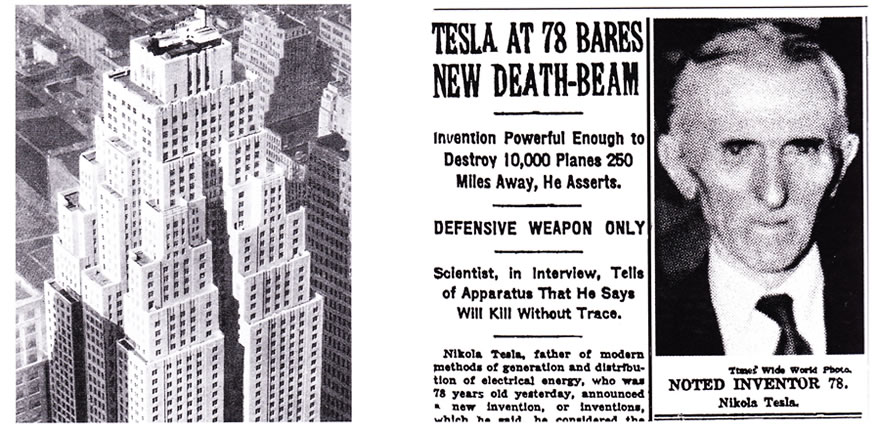
(L) Postcard illustration of the Hotel New Yorker, New York City. (Collection of The New-York Historical Society)(R) Tesla announced his new beam weapon in numerous newspaper interviews
on his seventy-eighth birthday.
This article is from The New York Times, July 11, 1934.
In 1934 Tesla moved to his final residence, room 3327 (still divisible
by three) of the recently completed Hotel New Yorker. There he lived alone with his ideas and his pigeons for the next decade. He posted a typewritten note on the door: "Please Do Not Disturb The Occupant Of This Room."
In Tesla's mind, it was time to reveal his greatest invention: a perfect
and impossible idea, a weapon to prevent World War II.
On July 11, 1934, the headline on the front page of the New York
Times screamed, "TESLA AT 78 BARES NEW DEATH-BEAM." The
invention, the article reported, will send concentrated beams of particles through the free air, of such tremendous energy that they will bring down a fleet of 10,000 enemy airplanes at a distance of 250 miles from a defending nation's border and will cause armies of millions to drop dead in their tracks. When put in operation, Dr. Tesla said, this latest invention of his would make war impossible. This death-beam, he asserted would surround each country like an invisible Chinese wall, only a million times more impenetrable. It would make every nation impregnable against attack by airplanes or by large invading armies. [...]
Joseph Butler, a U.S. Air Force expert on beam weapons, has said of Tesla's idea, "Definitely, he had the concept of a charged particle beam
weapon back in the 1930s. The concept was right on the mark ... particles projected out long distances to do damage to some enemy airplanes, in his particular case." But Butler added, "I haven't a clue how
he meant to actually do it" (interview with the authors, 1998).
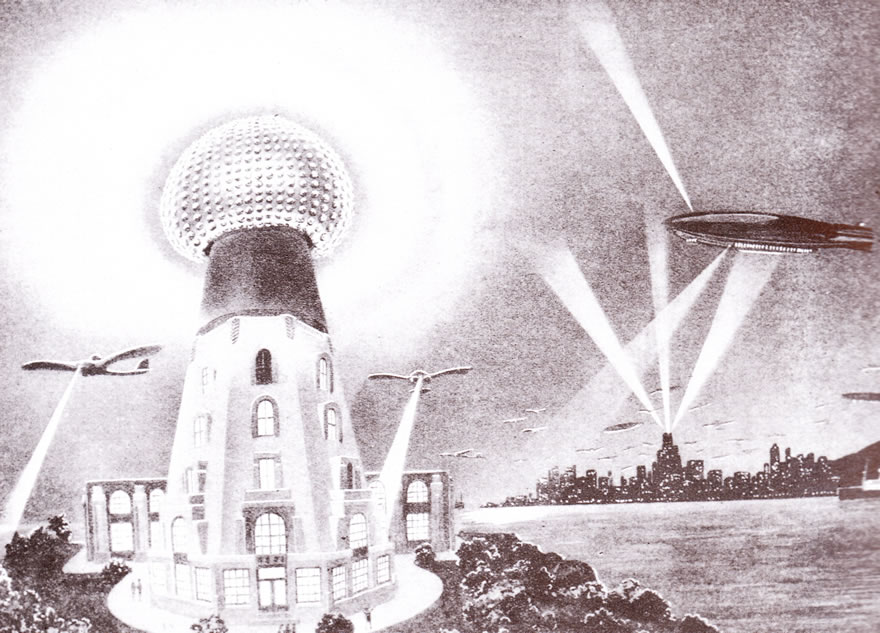
Tesla's system of transmission of power to aircraft by radio. Illustrated
by Frank Paul for Radio News, December 1925.
Enigmatic to the End
Tesla's friend Kenneth Swezey also visited and was equally alarmed by
his condition, particularly when he saw that Tesla was subsisting on warm milk and Nabisco crackers. He noted that the empty enameled cracker cans were stacked on shelves and used to hold various things. Word began to spread that the great inventor was near death.
Late in December of 1942, with the war at its height, two young men identifying themselves as U.S. government agents suddenly entered Tesla's life. One was a member of the OSS (predecessor to the CIA) named Ralph Bergstresser.
The other, Bloyce Fitzgerald, was an expert on ballistics technology working with the Massachusetts Institute of Technology. According to Bergstresser, Tesla agreed to share his most sensitive documents with them and allowed them to carry stacks of material away for microfilming. Based on their review, the two men were able to arrange a meeting at the White House on January 8, 1943, with Roosevelt's science advisor and other high-ranking officials. Tesla was too ill to attend (interview with the authors, 1993).
Meanwhile a prominent Yugoslav writer, Louis Adamic (The Immigrant's
Return), wrote a letter to Eleanor Roosevelt on December 29 describing
the inventor's circumstances: Today he is ... worse than penniless. He is extremely frail, weighing less than 90 pounds. His health is poor; he has grown somewhat bitter against his country, the United States ... He suffers, too, to the point of bitterness, because he feels that everyone in America, including beneficiaries of fortunes created by his inventions, has forgotten him.
... The fact now is that he is up against it ... This letter is not
an appeal to help him financially. ... This is merely to suggest that
the President write him a letter which will indicate that America has
not forgotten [him]. Perhaps this coming New Year is a good occasion
for such a letter (Adamic 1942).
New Year's Eve came and went, and there was no letter. Tesla's loyal
associate, George Scherff, visited him on January 4 to help him prepare
for an experiment. The final project, its nature unknown, was terminated
when Tesla complained of sharp pains in his chest. He refused medical
aid. Scherff left the hotel, bidding him goodbye for the last time.

On the night of January 7, 1943, the eve of the Orthodox Christmas, snow
fell on New York City. In a darkened room on the thirty-third floor of
the Hotel New Yorker, Tesla lay listening to the clamor of traffic below.
His great legacy, the technological world he had helped create, would
continue without him. There would be no more riveting announcements, or shrieks of "Eureka," or terrifying bolts of lightning leaping in his laboratory. The pigeons on the window ledge stirred their feet and ruffled their feathers. Hard times lay ahead for the pigeons; he had nothing to leave them. Nikola Tesla, aged eighty-six, died in his sleep. The coroner's report read: "No suspicious circumstances."
The Cosmic Signature
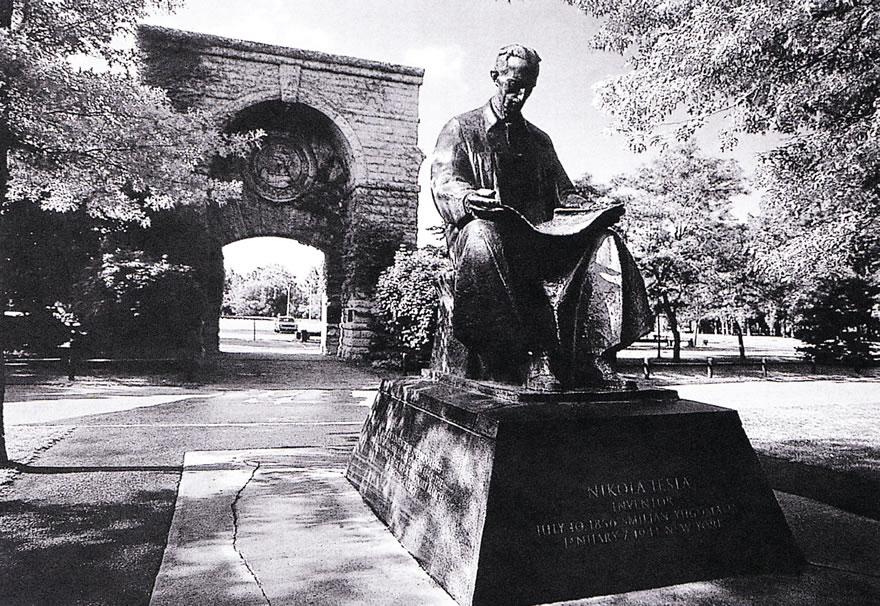
Nikola Tesla monument installed at Goat Island, Niagara Falls, a gift
to the United States on the occasion of its bicentennial and Tesla's 120th
anniversary, July 23, 1976. The monument is a second casting of the sculpture -- by Fran Krsinic.
The first casting is installed in front of the Faculty of Electrical Engineering
Building, University of Belgrade.
The world would be a very different place without the ideas and inventions of Nikola Tesla. With the flick of a switch the power of the waterfall and the coal furnace is transported to our fingertips. Worldwide communication reach nearly every person on the planet. A remote-controlled device has explored the surface of Mars. And at this moment, receivers are pointed at the heavens waiting for a message from afar. One can picture the inventor nodding, then shrugging, and perhaps wondering what took us so long. In the end, Tesla was one of our greatest dreamers, and great dreams have a way of becoming reality. The inventor consoled himself by saying, "The scientific man does not aim at an immediate result. He does not expect that his advanced ideas will be readily taken up. His work is like that of a planter - for the future. His duty is to lay the foundation for those who are to come, and point the way. (Tesla, My inventions: My early life. -- Electrical Experimenter; February 191
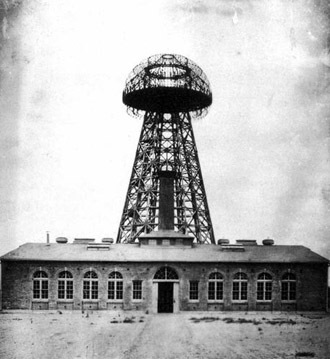 The Plekhanov brothers are raising money through IndieGogo kickstarter. The campaign will last until July 25. So far the project has managed to collect only 2 percent of the desired sum (about $18,000 out of the desired $800,000 as we publish this article).
The Plekhanov brothers are raising money through IndieGogo kickstarter. The campaign will last until July 25. So far the project has managed to collect only 2 percent of the desired sum (about $18,000 out of the desired $800,000 as we publish this article).
